Offering a free trial is one of the most effective ways to introduce potential customers to your product. However, getting users to sign up for a trial is only half the battle—the real challenge is converting those users into paying customers. Optimizing your free trial conversion rate is crucial for sustained business growth and long-term profitability.
What is Free Trial Conversion Rate?
A free trial conversion rate refers to the percentage of users who sign up for a free trial of your product or service and eventually become paying customers. It’s a critical metric for businesses that operate on subscription or Software-as-a-Service (SaaS) models, as it directly influences revenue, customer acquisition costs, and overall business success.
For example, if 100 users sign up for a free trial and 20 decide to pay for the product, your free trial conversion rate is 20%. A higher conversion rate suggests that users are finding value in your product. A lower rate may indicate that they’re not entirely convinced or encounter barriers during the trial period.
How to Calculate Free Trial Conversion Rate
The formula to calculate the free trial conversion rate is straightforward:
Free Trial Conversion Rate (%) = (Number of Converted Users / Total Number of Trial Users) × 100
Example Calculation:
- Total Number of Trial Users: 200
- Number of Users Who Converted to Paid: 40
- Free Trial Conversion Rate (%) = (40 / 200) × 100 = 20%
Tracking this metric over time can help you gauge the effectiveness of your trial and marketing strategies, and it provides insights into areas that may need improvement.
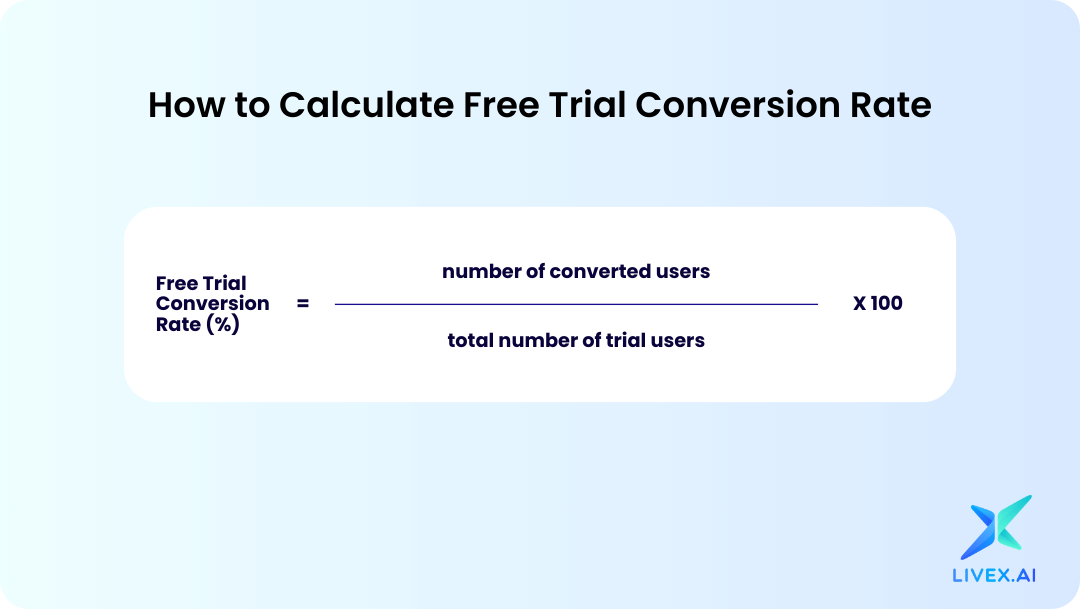
Factors Affecting Free Trial Conversion Rate
As with most business strategies, some factors are beyond your control, while others can be influenced. Understanding these will help you focus on areas where you can have the greatest impact.
Factors You Can’t Change
- Industry
Different industries have varying conversion rates due to customer behaviors and expectations. Comparing your free trial conversion rate to others in your industry can provide a better understanding of where you stand relative to your competitors. Here are some average benchmarks by industry, according to FirstPageSage:
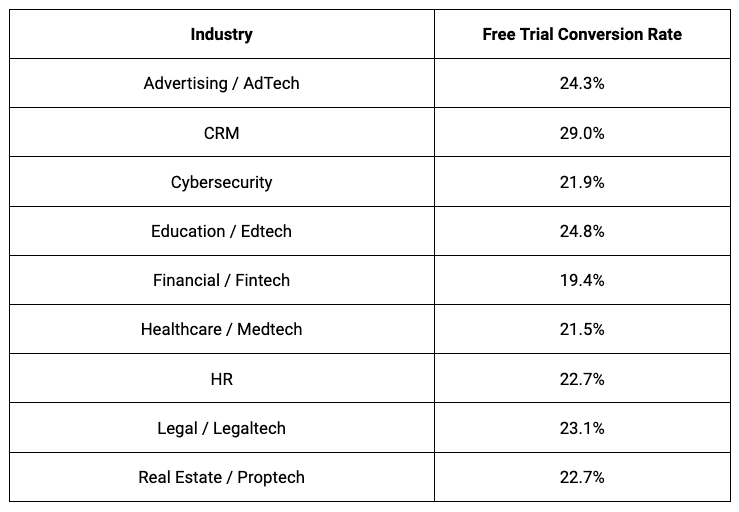
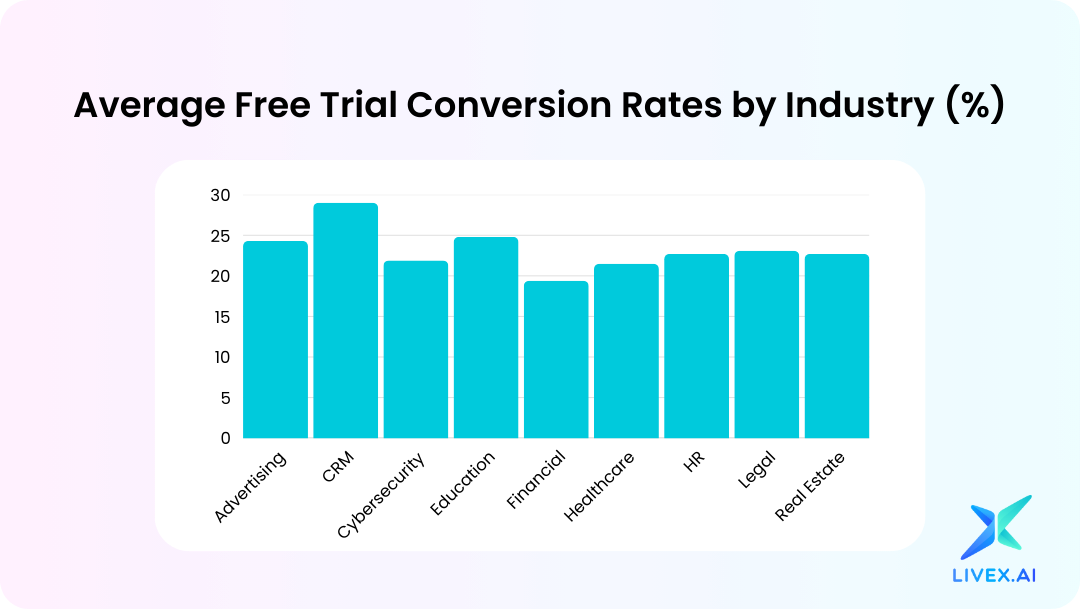
- B2B vs. B2C
In B2B models, conversions tend to be lower as businesses typically require more time, multiple stakeholders, and lengthy deliberations before committing to a paid plan. B2C, on the other hand, tends to have quicker, more impulsive decision-making processes. - Product Type
Products that require customization, complex onboarding, or additional training often struggle with free trial conversions because users may not experience the full value during a short trial period. - Regulatory Environment
Strict regulations in industries such as healthcare, finance, or insurance can pose barriers to free trial conversion, as users may need to ensure compliance before committing to a solution.
7 Proven Methods to Increase Free Trial Conversion Rate
While you can’t change every factor, the good news is there are several proven strategies that can help boost your free trial conversion rate. Here are seven methods to help convert trial users into paying customers.
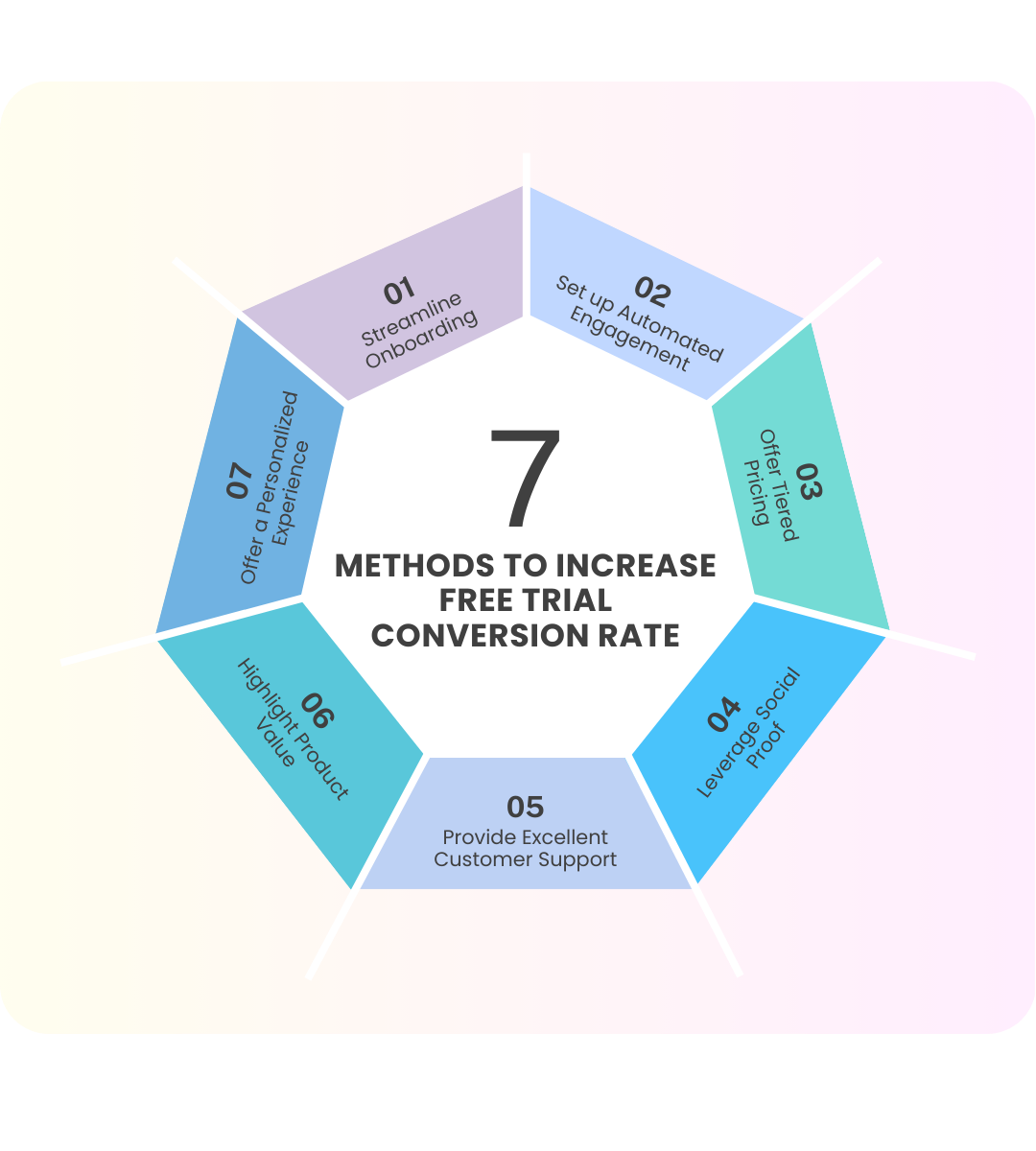
Method 1: Streamline Onboarding
An efficient and user-friendly onboarding process is crucial for converting trial users. The goal should be to help users experience the core value of your product as quickly as possible. Offering clear, step-by-step instructions, personalized tutorials, in-app guides, and helpful tips can reduce friction and ensure users achieve success faster. Tools like LiveX AI Chat can support this process by providing interactive, real-time proactive guidance (with optional avatars) to help users navigate your product with ease.
Method 2: Set Up Automated Engagement
Engaging with users throughout the trial period is key to maintaining their interest. Don’t wait until the end—set up automated email sequences, push notifications, or in-app messages that highlight key features, offer assistance, and remind users of the benefits they’re experiencing.
Method 3: Offer Tiered Pricing or Discounts
During the trial, present users with multiple pricing options based on their needs. Offering a lower-tier plan or discounted pricing as an incentive can make the decision to upgrade easier. Limited-time discounts at the end of the trial create urgency and can nudge users to commit before the offer expires.
Method 4: Leverage Social Proof
Highlighting testimonials, case studies, and user success stories can significantly impact your conversion rate. Demonstrating how your product has helped other businesses or individuals succeed reassures trial users that they are making the right decision by upgrading. Social proof builds trust and credibility, both key factors in conversions.
Method 5: Provide Excellent Customer Support
Responsive, helpful customer support can be the deciding factor for trial users considering upgrading. Ensure that trial users have access to real-time chat support, a comprehensive knowledge base, or even dedicated account managers. Proactive outreach, such as checking in to resolve potential issues, can increase satisfaction and build positive customer relationships. With tools like LiveX AI Search, users can interact directly through the support search bar, getting the help they need quickly and seamlessly.
Method 6: Highlight Product Value
Throughout the trial period, emphasize the unique value of your product’s features. Whether through targeted emails or in-app notifications, regularly remind users of the key features they have yet to explore. Providing real-world examples of how these features can solve their problems will help users visualize the benefits of upgrading.
Method 7: Offer a Personalized Experience
Personalizing the user experience can significantly improve your free trial conversion rate. By analyzing user behavior during the trial, you can offer tailored recommendations and send targeted messages that highlight the most relevant features for each user. Personalization helps create a more meaningful connection with trial users, addressing their unique needs and keeping them engaged throughout the trial period.
What You Should Analyze
While the seven methods outlined above are generally applicable to all businesses in improving free trial conversions, some factors must be adjusted based on your specific audience or product. It's essential to analyze these variables to ensure you're optimizing for your unique customer base:
- Trial Period Length
The ideal trial period varies by product type and customer segment. Some users may need a shorter trial (7-10 days) to experience the value, while others may need longer (14-30 days) to fully engage with complex features. Analyze which trial length works best for your target audience by experimenting and monitoring user engagement. - Pricing Transparency
Different customer segments respond differently to pricing structures. Some may prefer clear, upfront pricing during the trial, while others may need more time exploring the product before considering cost. Analyze when and how to introduce pricing discussions to best match your audience’s decision-making process.
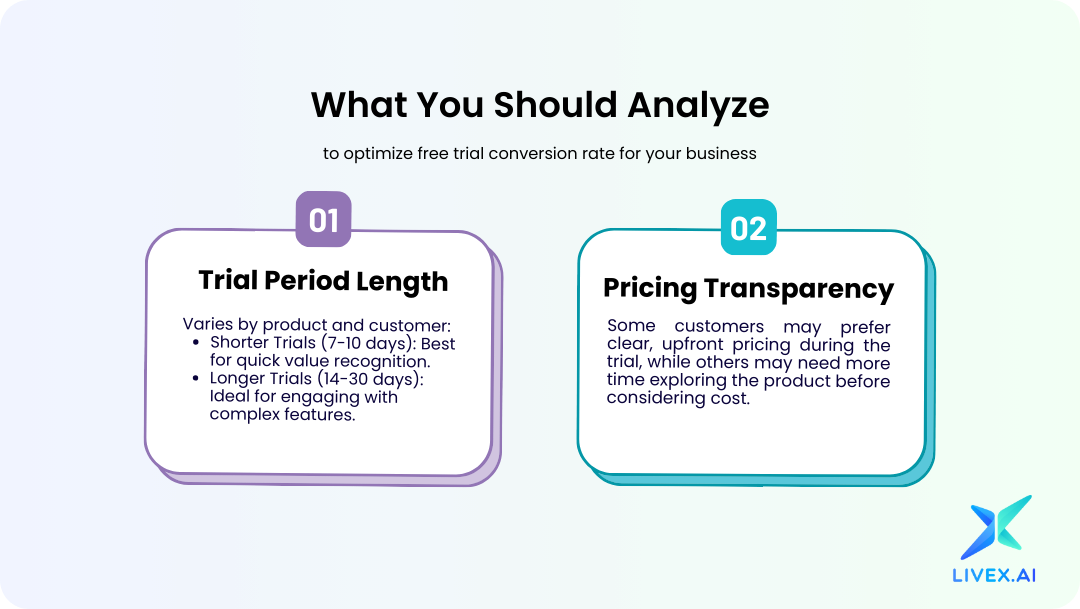
LiveX AI ChurnControl
While implementing these strategies can significantly improve your free trial conversion rate, some users may still hesitate to upgrade. This is where LiveX AI ChurnControl comes into play, providing a targeted approach to retain those users and enhance conversion rates.
- Proactive Intervention: ChurnControl steps in with timely, personalized messages when users indicate they might opt out of their free trial. It offers alternatives to cancellation, such as extended trial periods or tailored discounts, directly addressing users’ concerns.
- Personalized Offers: By analyzing user behavior, ChurnControl delivers customized solutions that resonate with each user’s experience. For example, if a user struggles with specific features, ChurnControl can suggest a plan that better fits their usage patterns or recommend features that may resolve their issues.
- Data-Driven Retention Strategies: ChurnControl continuously learns from user interactions, refining its strategies to optimize both retention and conversion. This ensures that users receive relevant offers that resonate with them, further enhancing the likelihood of conversion.
By integrating ChurnControl into your retention strategy, you can effectively turn potential cancellations into conversions, ensuring that users see the true value of your offering.
Conclusion
Increasing your free trial conversion rate is critical for growing your subscription-based business, but it’s important to remember that optimizing this rate isn’t the end goal. For example, shifting from an opt-in free trial, where users get their free trial without sharing credit card details, to an opt-out free trial, where users are automatically charged unless they cancel, will likely boost conversions, but it could lead to dissatisfied customers and higher churn in the long run.
Focus on providing value during the trial, building strong relationships with users, and fostering trust. By combining these proven methods with ongoing analysis, you’ll be well on your way to turning more trial users into paying customers while maintaining a healthy balance between conversions and long-term satisfaction. Throughout this whole process, LiveX AI is here to support your journey with our comprehensive product suite. Get in touch so that we can assist you!
FAQs
- How soon should I reach out to trial users after they sign up?
Engagement should start immediately. Welcome emails, tutorials, or a brief call to action can set the tone for their trial experience and ensure they get the most out of your product from day one. - When should I start preparing users for the transition from trial to paid subscription?
Start communicating the value of the paid subscription well before the trial ends. Share success stories, offer exclusive content, and provide clear instructions on how to upgrade to ensure users feel prepared and informed about the transition. - What is the ideal free trial length to optimize conversions?
Ultimately, you will have to analyze this based on your specific business and audience. Here are some steps to help you determine the optimal trial length: - Analyze User Behavior: Monitor how users engage with your product during the trial period by tracking key metrics such as usage frequency, session duration, and feature adoption rates. Consider utilizing analytics tools, like those offered by ChurnControl to gain deeper insights into user patterns and preferences, allowing you to make data-driven adjustments to enhance the trial experience.
- Conduct A/B Testing: Experiment with different trial lengths (e.g., 7, 14, 21, and 30 days) to see which duration yields the highest conversion rates. Monitor the results to identify trends.
- Gather Feedback: Contact users who have completed their trials to ask about their experience. Understanding their perspective can provide insights into whether they felt rushed or had enough time to explore.
- Evaluate Industry Standards: Many SaaS companies find that a trial length of 14 to 30 days strikes the right balance, allowing users ample time to explore features without feeling overwhelmed. However, tailor this based on your findings and industry specifics.
- What should I do if my conversion rate is consistently low despite trying multiple strategies?
It may be time to reassess your product-market fit. Consider conducting market research or competitor analysis to identify gaps or areas for improvement in your offering. Additionally, gathering detailed user feedback can provide insights into their specific concerns. - Is it worth offering a freemium model instead of a free trial to improve conversion rates?
This depends on your business model and product type. A freemium model can attract a larger user base, but it may lead to lower conversion rates if users don’t see the value in upgrading. Analyze your target audience and market to determine which model may work better for your business.
